Beyond Noise: Using Temporal ICA to Extract Meaningful Information from High-Frequency fMRI Signal Fluctuations during Rest
- PMID: 23641208
- PMCID: PMC3640215
- DOI: 10.3389/fnhum.2013.00168
Beyond Noise: Using Temporal ICA to Extract Meaningful Information from High-Frequency fMRI Signal Fluctuations during Rest
Abstract
Analysis of resting-state networks using fMRI usually ignores high-frequency fluctuations in the BOLD signal - be it because of low TR prohibiting the analysis of fluctuations with frequencies higher than 0.25 Hz (for a typical TR of 2 s), or because of the application of a bandpass filter (commonly restricting the signal to frequencies lower than 0.1 Hz). While the standard model of convolving neuronal activity with a hemodynamic response function suggests that the signal of interest in fMRI is characterized by slow fluctuation, it is in fact unclear whether the high-frequency dynamics of the signal consists of noise only. In this study, 10 subjects were scanned at 3 T during 6 min of rest using a multiband EPI sequence with a TR of 354 ms to critically sample fluctuations of up to 1.4 Hz. Preprocessed data were high-pass filtered to include only frequencies above 0.25 Hz, and voxelwise whole-brain temporal ICA (tICA) was used to identify consistent high-frequency signals. The resulting components include physiological background signal sources, most notably pulsation and heart-beat components, that can be specifically identified and localized with the method presented here. Perhaps more surprisingly, common resting-state networks like the default-mode network also emerge as separate tICA components. This means that high-frequency oscillations sampled with a rather T1-weighted contrast still contain specific information on these resting-state networks to consistently identify them, not consistent with the commonly held view that these networks operate on low-frequency fluctuations alone. Consequently, the use of bandpass filters in resting-state data analysis should be reconsidered, since this step eliminates potentially relevant information. Instead, more specific methods for the elimination of physiological background signals, for example by regression of physiological noise components, might prove to be viable alternatives.
Keywords: heart rate variability; resting-state fMRI; resting-state networks; temporal ICA.
Figures
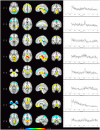


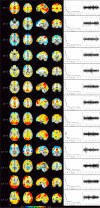

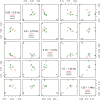
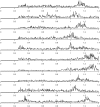
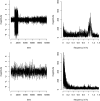
Similar articles
-
Studying the Spatial Distribution of Physiological Effects on BOLD Signals Using Ultrafast fMRI.Front Hum Neurosci. 2014 Apr 1;8:196. doi: 10.3389/fnhum.2014.00196. eCollection 2014. Front Hum Neurosci. 2014. PMID: 24744722 Free PMC article.
-
The spectral diversity of resting-state fluctuations in the human brain.PLoS One. 2014 Apr 11;9(4):e93375. doi: 10.1371/journal.pone.0093375. eCollection 2014. PLoS One. 2014. PMID: 24728207 Free PMC article.
-
BOLD fractional contribution to resting-state functional connectivity above 0.1 Hz.Neuroimage. 2015 Feb 15;107:207-218. doi: 10.1016/j.neuroimage.2014.12.012. Epub 2014 Dec 12. Neuroimage. 2015. PMID: 25497686 Free PMC article.
-
Low Frequency Systemic Hemodynamic "Noise" in Resting State BOLD fMRI: Characteristics, Causes, Implications, Mitigation Strategies, and Applications.Front Neurosci. 2019 Aug 14;13:787. doi: 10.3389/fnins.2019.00787. eCollection 2019. Front Neurosci. 2019. PMID: 31474815 Free PMC article. Review.
-
Mapping cognitive and emotional networks in neurosurgical patients using resting-state functional magnetic resonance imaging.Neurosurg Focus. 2020 Feb 1;48(2):E9. doi: 10.3171/2019.11.FOCUS19773. Neurosurg Focus. 2020. PMID: 32006946 Free PMC article. Review.
Cited by
-
Enhanced identification of BOLD-like components with multi-echo simultaneous multi-slice (MESMS) fMRI and multi-echo ICA.Neuroimage. 2015 May 15;112:43-51. doi: 10.1016/j.neuroimage.2015.02.052. Epub 2015 Mar 2. Neuroimage. 2015. PMID: 25743045 Free PMC article.
-
High frequency functional brain networks in neonates revealed by rapid acquisition resting state fMRI.Hum Brain Mapp. 2015 Jul;36(7):2483-94. doi: 10.1002/hbm.22786. Epub 2015 Mar 18. Hum Brain Mapp. 2015. PMID: 25787931 Free PMC article.
-
Disentangling Multispectral Functional Connectivity With Wavelets.Front Neurosci. 2018 Nov 6;12:812. doi: 10.3389/fnins.2018.00812. eCollection 2018. Front Neurosci. 2018. PMID: 30459548 Free PMC article.
-
High-speed real-time resting-state FMRI using multi-slab echo-volumar imaging.Front Hum Neurosci. 2013 Aug 26;7:479. doi: 10.3389/fnhum.2013.00479. eCollection 2013. Front Hum Neurosci. 2013. PMID: 23986677 Free PMC article.
-
Studying the Spatial Distribution of Physiological Effects on BOLD Signals Using Ultrafast fMRI.Front Hum Neurosci. 2014 Apr 1;8:196. doi: 10.3389/fnhum.2014.00196. eCollection 2014. Front Hum Neurosci. 2014. PMID: 24744722 Free PMC article.
References
-
- Baglama J., Reichel L. (2005). Augmented implicitly restarted Lanczos bidiagonalization methods. SIAM J. Sci. Comput. 27, 19–4210.1137/04060593X - DOI
-
- Baglama J., Reichel L. (2012). irlba: Fast Partial SVD by Implicitly-Restarted Lanczos Bidiagonalization. R Package Version 1.0.2. Available at: http://CRAN.R-project.org/package=irlba
Grants and funding
LinkOut - more resources
Full Text Sources
Other Literature Sources
Miscellaneous

